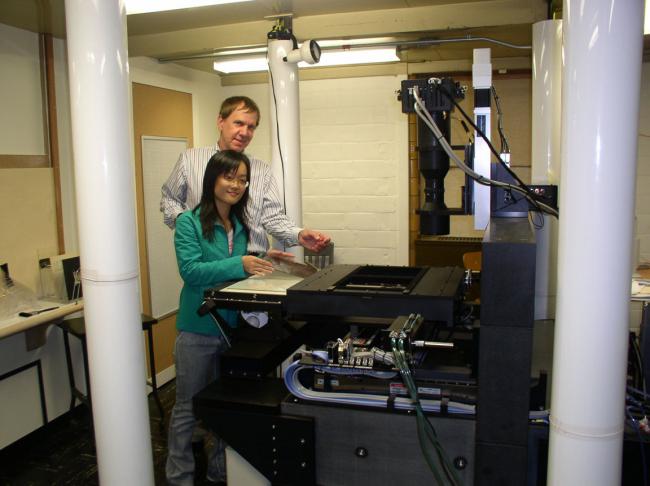
CfA astronomers Sumin Tang and Jonathan Grindlay with the DASCH (Digital Access to a Sky Century at Harvard) scanner that is digitizing 100 years of astronomical photographs.
Modern astronomy sometimes makes discoveries by looking in new places, the distant universe for example, using telescopes and instruments that extend the previous limits of detection. But sometimes new discoveries can come from applying modern technologies to the task of more carefully examining conventional data. The Harvard College Observatory maintains a collection of more than 500,000 glass photographic plates of the sky taken over a century - from between about 1880 and 1980. They constitute the only continuous record of the whole sky in existence for this period, with every point on the sky having been observed between 500 and 1000 times. The Digital Access to a Sky Century at Harvard (DASCH) is a project now underway to digitize all of these plates and search for changes. In one of the first results of this ongoing program, a new class of variable stars has been discovered.
Variable stars are stars that change in brightness. They can do so for many reasons, from explosions as supernovae to pulsations in their atmospheres to eclipses in binary star systems. Sometimes the changes are periodic and other times erratic, but by far most known variable stars change noticeably in short times - over time scales of less than a year. Variable stars came as quite a shock when they were discovered in the early 1600's because people thought that the stars were cosmic constants, but today variable stars seem rather matter-of-course.
CfA astronomers Sumin Tang, Jonathan Grindlay, and Edward Los, together with a former CfA postdoc Silas Laycock, used some of the first results of the DASCH project to discover three objects in what appears to be a new class of variable stars that change in optical brightness (both dimming and brightening) by more than a factor of two over a timescale of 10-100 years. This kind of variation has never been seen before; imagine if the sun were to vary in brightness by a factor of two in a century! The astronomers use follow-up spectroscopic observations to report that the three stars are very similar to one another: all three are giants, and are slightly cooler and less massive but older than the sun. They suggest that the cause of variability could be related to the production of dust, or else involve changes in the nuclear reactions underway. Once DASCH has found other stars of this type, and more detailed followup studies can be be undertaken, this new kind of variable star can add the details of its aging personality to our understanding of what happens as stars evolve into giants through previously unseen phases of evolution.